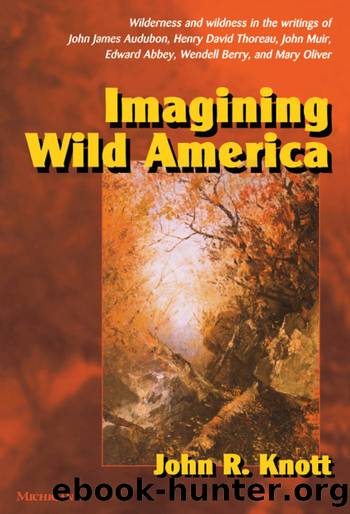Imagining Wild America by Knott John R.;

Author:Knott, John R.;
Language: eng
Format: epub
Publisher: University of Michigan Press
Over the desert and the canyons, down there in the rocks, a huge vibration of light and stillness and solitude shapes itself into the form of hovering wings spread out across the sky from the worldâs rim to the worldâs end. Not Godâthe term seems insufficientâbut something unnameable, and more beautiful, and far greater, and more terrible. (AR, 120)
This is something beyond the mystery of the obvious, a suggestion of a presence much larger and more powerful than anything one could expect to find in the visible scene. One could call it a kind of desert sublime, arousing awe and fear, which Abbey responds to despite his hard-boiled rejection of the supernatural and the fraudulently mystical. In his classic The Desert (1901), which Abbey admired, John Van Dyke asks, âWhat is it that draws us to the boundless and the fathomless?â and concludes that it is the sublime that we feel in âimmensity and mystery.â21 Abbey does not invoke the sublime so readily, and his temperament was profoundly different from Van Dykeâs, yet his response to the mysteriousness of the desert resembles Van Dykeâs and may have been shaped by it. Van Dyke anticipated Abbey and other writers on the American desert in his emphasis on the desertâs silences, the âsplendor of its light,â and the paradoxical grandeur of its desolation.
Abbeyâs transient vision of hovering wings holds a suggestion of terror as well as of beauty because the immense stillness conveys a sense of nothingness that seems wholly alien to ordinary human consciousness and points to the annihilation of consciousness in death. In an interview Abbey once said, âI am terrified and at the same time fascinated by solitude, silence, and death,â and went on to comment on his attraction to the âsilent tension between death and lifeâ that he found in the desert.22 One sees the danger in the appeal of the nothingness Abbey finds in the desert in his attraction to the abyss, particularly apparent in the Grandview Point chapter of Desert Solitaire. Searching along the rim of the canyon for the tourist who will eventually be found dead, he looks down into the âawful dizzying vacancyâ and imagines that the man might have gone over the edge deliberately, âspellbound by that fulfillment of nothingnessâ (DS, 238). The passage suggests Abbeyâs own romantic attraction to death, seen as the ultimate way of merging with the other world of the desert. His frequently stated wish to die on a rock in the desert, which he tried to realize in fact, is one form this attraction takes. Here it takes the form of envy of the touristâs actual manner of dying: âalone, on rock under sun at the brink of the unknown, like a wolf, like a great bird . . . before this desert vastness opening like a window onto eternityâ (DS, 240). Jeffers anticipated Abbey in this wish, imagining himself crawling out on a ledge to die like a wolf (âThe Deer Lay Down Their Bonesâ), as he had in the wish to become a part of the vulture he imagined feeding on him (âVultureâ).
Download
This site does not store any files on its server. We only index and link to content provided by other sites. Please contact the content providers to delete copyright contents if any and email us, we'll remove relevant links or contents immediately.
The Power of Myth by Joseph Campbell & Bill Moyers(940)
Half Moon Bay by Jonathan Kellerman & Jesse Kellerman(921)
A Social History of the Media by Peter Burke & Peter Burke(888)
Inseparable by Emma Donoghue(855)
The Nets of Modernism: Henry James, Virginia Woolf, James Joyce, and Sigmund Freud by Maud Ellmann(773)
The Spike by Mark Humphries;(730)
A Theory of Narrative Drawing by Simon Grennan(717)
The Complete Correspondence 1928-1940 by Theodor W. Adorno & Walter Benjamin(713)
Ideology by Eagleton Terry;(666)
Bodies from the Library 3 by Tony Medawar(657)
World Philology by(650)
Culture by Terry Eagleton(649)
Farnsworth's Classical English Rhetoric by Ward Farnsworth(648)
Adam Smith by Jonathan Conlin(620)
A Reader’s Companion to J. D. Salinger’s The Catcher in the Rye by Peter Beidler(617)
Game of Thrones and Philosophy by William Irwin(604)
High Albania by M. Edith Durham(599)
Comic Genius: Portraits of Funny People by(588)
Monkey King by Wu Cheng'en(583)
